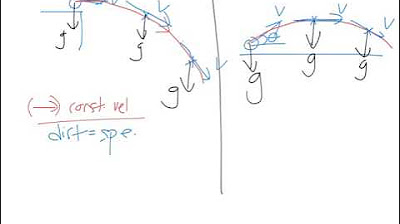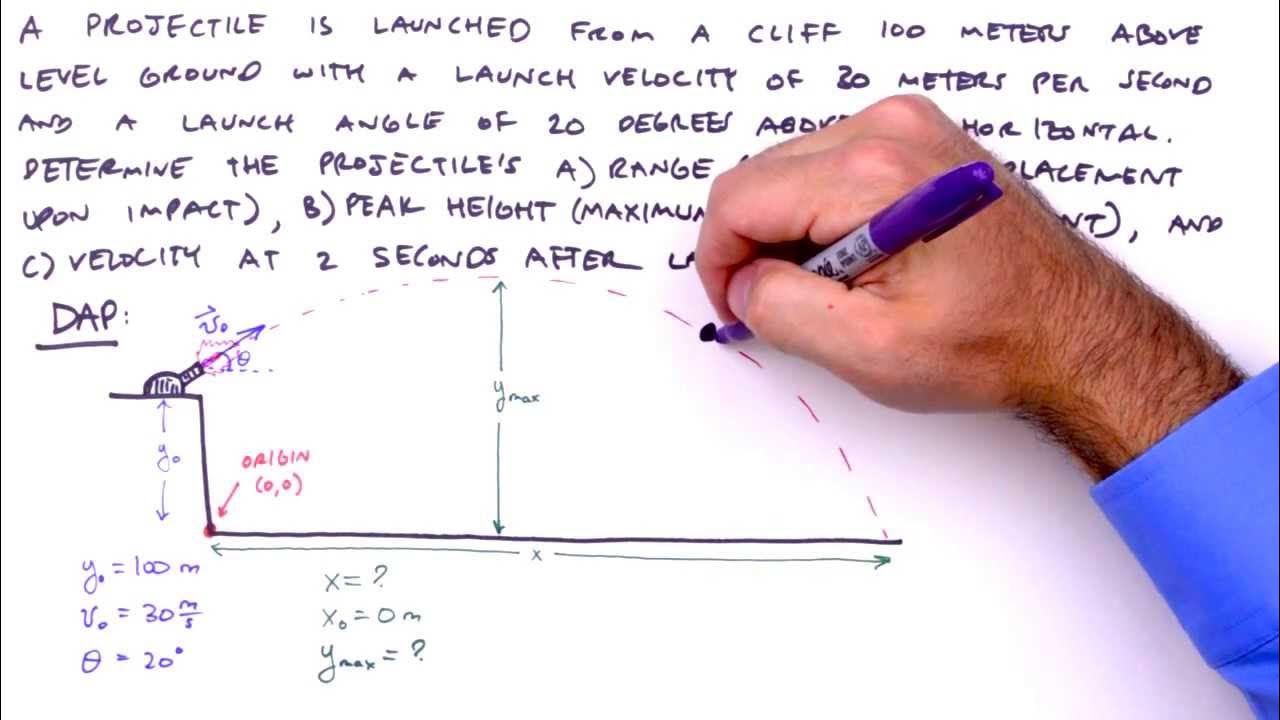Horizontally launched projectile | Two-dimensional motion | Physics | Khan Academy
Summary
TLDRIn this instructional video, the instructor explains how to solve horizontally launched projectile problems, emphasizing the independence of horizontal and vertical motions. Using the example of a cliff diver running off a 30-meter cliff with an initial horizontal velocity of 5 meters per second, the video highlights common misconceptions, particularly the initial vertical velocity being zero. The instructor walks through the calculations for time of flight and horizontal distance, ultimately demonstrating how the diver travels approximately 12.4 meters before hitting the water. Key takeaways include the importance of correct initial conditions and sign conventions in projectile motion.
Takeaways
- 😀 A horizontally launched projectile starts with a horizontal velocity and no initial vertical component.
- 📏 Horizontal motion is independent of vertical motion, maintaining a constant horizontal velocity throughout the fall.
- 🏞️ A classic example of a horizontally launched projectile is a person running off a cliff or a ball rolling off a table.
- ⏱️ The time of flight for the projectile can be calculated using vertical motion parameters, as the time is the same for both x and y directions.
- 📉 The vertical displacement must be considered negative when calculating downward motion, adhering to conventional physics notation.
- 🛑 It's crucial to remember that the initial vertical velocity for a horizontally launched projectile is zero, not the given horizontal velocity.
- 📊 The acceleration in the vertical direction due to gravity is approximately -9.8 m/s², affecting the vertical velocity but not the horizontal velocity.
- 🔄 The time of flight can be found using the formula: Δy = v₀y * t + 0.5 * a * t².
- ➡️ The horizontal distance traveled can be calculated with the formula: Δx = v₀x * t, using the time derived from vertical motion.
- ⚠️ Avoid common mistakes such as mislabeling the initial vertical velocity or neglecting the negative displacement when falling.
Q & A
What defines a horizontally launched projectile?
-A horizontally launched projectile is defined as an object that is launched with a completely horizontal initial velocity and no vertical component.
Can you provide an example of a horizontally launched projectile?
-An example would be a ball rolling off a flat table or a person running straight off a cliff without jumping.
What initial speed does the cliff diver have in the example given?
-The cliff diver has an initial speed of 5 meters per second as they run off the cliff.
How tall is the cliff in the example?
-The cliff is 30 meters tall, which is approximately over 90 feet.
What is the key mistake students make when solving these problems?
-A common mistake is assuming the initial vertical velocity is equal to the horizontal velocity, when in fact, the initial vertical velocity is zero.
Why is the vertical displacement negative in this scenario?
-The vertical displacement is negative because the diver falls downward 30 meters from the starting point at the top of the cliff.
What is the acceleration due to gravity used in these calculations?
-The acceleration due to gravity is typically -9.8 meters per second squared, with downward considered as negative.
How long does it take for the diver to reach the water?
-It takes approximately 2.47 seconds for the diver to fall 30 meters vertically.
What formula is used to calculate the time of flight?
-The formula used is delta y = v_initial_y * t + 0.5 * a_y * t^2, where delta y is the vertical displacement, v_initial_y is the initial vertical velocity, a_y is the vertical acceleration, and t is time.
How far does the diver travel horizontally before hitting the water?
-The diver travels approximately 12.4 meters horizontally before hitting the water.
Outlines

This section is available to paid users only. Please upgrade to access this part.
Upgrade NowMindmap

This section is available to paid users only. Please upgrade to access this part.
Upgrade NowKeywords

This section is available to paid users only. Please upgrade to access this part.
Upgrade NowHighlights

This section is available to paid users only. Please upgrade to access this part.
Upgrade NowTranscripts

This section is available to paid users only. Please upgrade to access this part.
Upgrade NowBrowse More Related Video

How Do Horizontally Launched Projectiles Behave? | Physics in Motion

kinematics 6of6 projectile motion final

Motion Characteristics of a Projectile

Projectile Motion Part II | Quarter 4 Grade 9 Science Week 2 Lesson

Projectile Motion Part 1| Grade 9 Science Quarter 4 Week 1 Lesson

How To Solve Any Projectile Motion Problem (The Toolbox Method)
5.0 / 5 (0 votes)